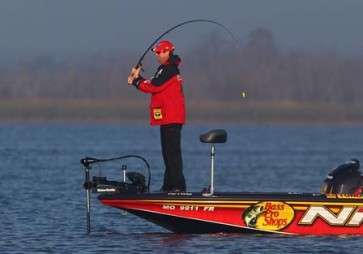
It amazes me how aggressive bass can be in cold water this time of year.
Sure, you can fish slow and methodically and catch ‘em. But as a power fisherman, I’ve learned that bass will still thump a spinnerbait and slam a crankbait despite falling water temperatures.
That’s especially true in southern climates, but northern anglers shouldn’t discount power fishing on lakes that haven’t frozen. You can still have some good days fishing horizontally-moving baits.
The thing to remember is that bass are more aggressive when the water is cooling after it’s been warm verses in the spring when it’s cold and getting warmer.
Most anglers think the opposite occurs, so they put their boats away, are deer hunting or watching football. The bass are getting far less pressure and can be easier to catch.
On reservoirs, the shad are still in the backs of creeks, but they’re hanging higher in the water column. In addition, on highland reservoirs, a transition occurs when bass move shallower to feed on crayfish.
Weather is a key to a good power fishing day. If it’s sunny and warming, I focus on afternoon fishing. By afternoon, the rising day temperatures have heated the shallows and upper water column. Even though you may not see a spike in water temperature, objects in the water absorb heat from the sun and radiate the water around them.
I will target northerly banks, coves, pockets, flats and weed edges — shallow places with cover that help radiate the heat. Anything with a darker bottom that is facing the sun has potential.
Up north that can be lily pad fields, muck bottoms and weed flats. In the south, it’s laying logs, boat docks, brush piles and riprap shores. Bait and bass will be drawn to those areas to soak up the warmth and get more active.
The bass tend to be shallower and more aggressive around areas with abundant cover. Now, on lakes like Lanier in Georgia, they are going to be slightly deeper because of the limited shore cover and deeper light penetration.
Also, shallow lakes often experience bigger temperature swings from night-to-day than deeper lakes. However, the radiant sunshine will pull fish shallower or closer to the surface on clear lakes.
I’ll fish a jerkbait and spinnerbait in clear water; a spinnerbait, square bill crankbait or lipless crankbait in off-color water.
A slow-rolled spinnerbait or suspending jerkbait is a good choice in both clear and stained water because you can fish it at whatever water depth you think the fish are using.
Nasty days, when the fronts are passing through, can be even better than warm sunny afternoons. Clouds, snow, rain and wind make power techniques even more effective.
It may not be a comfortable time to be out, but its prime time power fishing. I throw a lot of crankbaits and spinnerbaits in inclement weather, but I’ve also caught them on buzzbaits by casting right against the bank. I’ve seen it on Lake of the Ozarks and even Grand Lake, the Bassmaster Classic site, when it’s snowing.
I target areas where the wind is blowing into shallows that have deep water nearby, such as channel swings that turn onto the edge of a flat. The fish key on those areas because they want to pull shallow but not far from deep water.
As effective as power fishing can be, you still have to slow down. I don’t burn my baits; I fish them fairly slow but will run crankbaits at a medium speed.
Even though I may be fishing slower than normal, power fishing allows me to cover water and dial in the patterns more quickly — a proven strategy that works year round.





